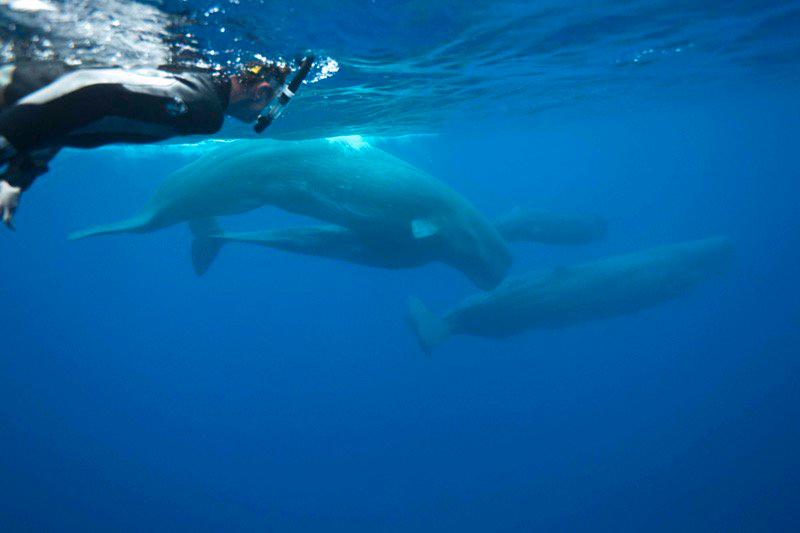A close encounter of the underwater kind
Peter Hoare diving in the Azores among a pod of sperm whales.
Marine scientists have spotted a pod of more than 80 North Atlantic right whales off the coast of Cape Cod. It’s pretty extraordinary when you realize there are only about 500 North Atlantic right whales in all of the world’s oceans.
Researchers at the Center for Coastal Studies in Provincetown spotted the whales from the air.
But seeing a whale underwater is a completely different thing.
“I mean if you’re lucky it will breach, it will jump right out, and that’s an astonishing sight,“ says writer Philip Hoare, who’s spent years writing about whales and their history. “But the whale is an enigmatic animal, because you have to put together the creature in your head as a kind of jigsaw puzzle. When you go below the surface, below what Herman Melville called the ‘ocean skin,’ you certainly see the enormity, I mean, it‘s like an iceberg.”
oembed://https%3A//www.youtube.com/watch%3Fv%3D4I_6IpoRI-M
One of Hoare’s favorite underwater encounters was a near-Jonah experience in the Atlantic near the Azores.
“It was my first encounter with sperm whales. I got in the water and the visibility was very reduced there in the mid-Atlantic, and I was swimming toward these animals before I could actually see them so I was only 20 feet away from them before I actually saw them, and suddenly my vision was wall-to-wall whales, a dozen whales, and unlike the blue whale, unlike humpbacks or fin whales, these are not baleen whales, these are toothed whales.
"They are the largest predator that ever lived. As I was watching, the largest of the whales started swimming directly at me, at which point I got very scared because I know that they are the only animal which could, and indeed have swallowed a human being, and it's not nice way to go,“ says Hoare.
Here’s what’s going through Hoare’s head as this sperm whale was coming closer and closer and closer to him.
“I kind of think, 'OK it’s either going to ram straight into me that huge, great square, pugnacious head or it’s going to open its mouth at the last moment.'“
Then, Hoare says he felt, he didn’t hear, he felt the "click-click-click" of its sonar moving through my body, "click-click-click" as the whale was taking a three-dimensional sound picture, “like an MRI scan being ‘beamed’ back sonically to its head.”
Then, “she came right alongside with this eye about the size of a grapefruit and looked directly at me and it was the most extraordinary moment because it was absolute sentience there, she was reading me, she was trying to work out what I was, what I was doing in her world. I was clearly not a fish, not a seal, I was clearly something else. Then she dove from this incredibly intense blue down to the velvety black below and just vanished. It was just the most extraordinary encounter, almost dream like.”
oembed://https%3A//www.youtube.com/watch%3Fv%3D-twxGVP1kck
Ultimately this connection, this kind of encounter, Hoare says, represents the best hope for the long term survival of whales. “Our empathy for them will be what ultimately saves them I think.”
Hoare’s latest book The Sea Inside partly explores why our attitudes toward these creatures have changed so drastically in just a few decades — from Moby Dick to Greenpeace.
